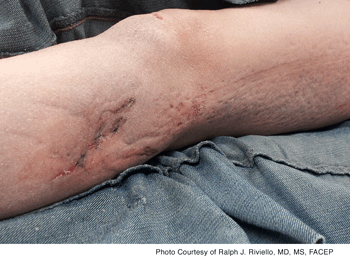
THE CASE
A 58-year-old female presents to the emergency department after being struck by a car in a parking lot. The car was backing up and struck the patient, causing her to fall to the ground. She did not lose consciousness but says she cannot identify the car or driver. She is reporting pain in her pelvis and lower extremities. The image depicts her right lower extremity. What is the finding?
PATTERN INJURIES AND DOMESTIC VIOLENCE
This is a patterned bruise (contusion) and shows a tire imprint indicating that the car ran her over after striking her. A pattern injury is an injury that possesses features or configuration of the object or surface that produces a mirror image of what caused it.1–3 They can be grouped into three types based on their source: blunt force, sharp force, and thermal. Pattern injuries are consistently reproducible. Many objects and surfaces have been implicated in causing pattern injury. Common objects include a looped cord/wire, a clothes iron, a curling iron, a cigarette, a tire, a belt or strap, tools, an open hand, fingertips, fingernails, carpets, teeth, ligatures, and shoes.2,4
Impact with a linear object like a bat or pipe will result in an area of central clearing surrounded by two parallel lines. The blood under the area of impact is forced up and out around the linear object, resulting in blood vessel rupture outside the area of impact.
Pattern injuries are often seen in cases of intimate violence, elder abuse, and child abuse.4–6 Emergency physicians should be suspicious of certain pattern injuries. Circular bruises (1 to 1.5 cm diameter) are concerning, for example, as they may have been caused by a fingertip (grab marks), especially if located in the medial upper arm.4,6
It’s important for emergency physicians to recognize an injury as a pattern injury in the case of violence so that the offending object can be identified and recovered by law enforcement and linked to the patient and perpetrator. DNA typing, ABO blood typing, and fingerprinting can then be performed on the object. Precise documentation of injury location(s) and wound characteristics should be supplemented with photo documentation as part of the patient’s record.
REFERENCES
1. Three in four domestic violence victims go unidentified in emergency rooms, Penn study shows. University of Pennsylvania Health System website. Available at: http://www.uphs.upenn.edu/news/News_Releases/2011/03/emergency-room-domestic-violence-identification/. Accessed July 11, 2016.
2. Little D. Patterned injuries. Pathology. 2011;43(Suppl 1):S24.
3. Rao VJ. Patterned injury and its evidentiary value. J Forensic Sci. 1986;31(2):768-772.
4. Recognition of pattern injuries in domestic violence victims. What-When-How website. Available at: http://what-when-how.com/forensic-sciences/recognition-of-pattern-injuries-in-domestic-violence-victims. Accessed June 20, 2016.
5. McDowell JD. The role of health professionals in diagnosing patterned injuries from birth to death. In: Dorian RBJ, ed. Bitemark Evidence: A Color Atlas and Text. 2nd ed. Boca Raton, Fla: CRC Press; 2011:25-31.
6. Burnett LB. Domestic violence clinical presentation. Medscape website. Available at: http://emedicine.medscape.com/article/805546-clinical#b4. Accessed June 20, 2016.
Pages: 1 2 | Single Page





No Responses to “Pattern Bruises Provide Clues for Emergency Physicians Assessing Injury Cases”